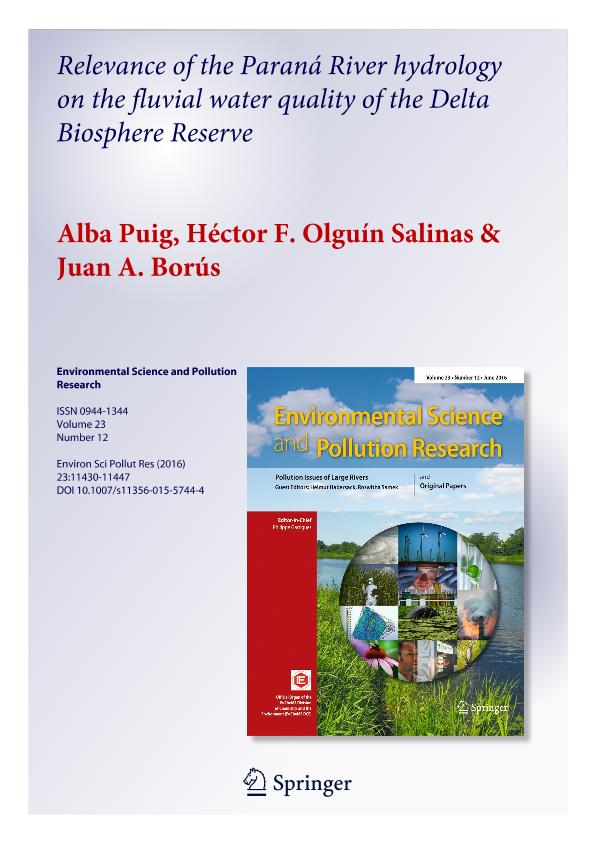Mostrar el registro sencillo del ítem
dc.contributor.author
Puig, Alba

dc.contributor.author
Olguin Salinas, Hector

dc.contributor.author
Borús, Juan A.
dc.date.available
2018-06-07T20:44:46Z
dc.date.issued
2015-11
dc.identifier.citation
Puig, Alba; Olguin Salinas, Hector; Borús, Juan A.; Relevance of the Paraná River hydrology on the fluvial water quality of the Delta Biosphere Reserve; Springer Heidelberg; Environmental Science and Pollution Research; 23; 12; 11-2015; 11430-11447
dc.identifier.issn
0944-1344
dc.identifier.uri
http://hdl.handle.net/11336/47789
dc.description.abstract
The increasing frequency of extreme events in large rivers may affect not only their flow, but also their water quality. In the present study, spatial and temporal changes in fluvial physico-chemical variables were analyzed in a mega-river delta during two extreme hydrological years (La Niña-El Niño) and related to potential explanatory factors. Basic water variables were evaluated in situ at 13 points (distant 2-35 km from each other) in watercourses of the Delta Biosphere Reserve (890 km2) in the Lower Paraná River (Argentina) in nine surveys (October 2008-July 2010) without meteorological tides. Samples for laboratory analyses were collected from each main river. Multivariate tests by permutations were applied. The period studied was influenced by a drought, within a long period dominated by low flows combined with dry weather and wildfires, and a large (10 years of recurrence) and prolonged (7 months) flood. The hydrological phase, followed by the season and the hydrological year (according to the ENSO event) were the principal explanatory factors of the main water quality changes, whereas the drainage sub-basin and the fluvial environment (river or stream) were secondary explanatory factors. During the drought period, conductivity, turbidity, and associated variables (e.g., major ions, silicon, and iron concentrations) were maximal, whereas real color was minimal. In the overbanking flood phase, pH and dissolved oxygen concentration were minimal, whereas real color was maximal. Dissolved oxygen saturation was also low in the receding flood phase and total major ion load doubled after the arrival of the overbanking stage. The water quality of these watercourses may be affected by the combination of several influences, such as the Paraná River flow, the pulses with sediments and solutes from the Bermejo River, the export of the Delta floodplain properties mainly by the flood, the season, and the saline tributaries to the Lower Paraná River. The high influence of the hydrology of this large river on the Delta fluvial water quality emphasizes the relevance of changes in its flow regime in recent decades, such as the seasonality attenuation. Considering that the effects of extreme events differ among and within fluvial systems, specific ecohydrological evaluations and powerful appropriate statistics are key tools to gain knowledge on these systems and to provide bases for suitable management measures in a scenario of climate change and increasing human alterations and demands.
dc.format
application/pdf
dc.language.iso
eng
dc.publisher
Springer Heidelberg

dc.rights
info:eu-repo/semantics/openAccess
dc.rights.uri
https://creativecommons.org/licenses/by-nc-sa/2.5/ar/
dc.subject
Physico-Chemical Assessment
dc.subject
Extreme Events
dc.subject
Canonical Analyses
dc.subject
Ecohydrology
dc.subject
Fluvial System
dc.subject
Enso
dc.subject
Southamerica
dc.subject
La Plata Basin
dc.subject.classification
Otras Ciencias Químicas

dc.subject.classification
Ciencias Químicas

dc.subject.classification
CIENCIAS NATURALES Y EXACTAS

dc.subject.classification
Meteorología y Ciencias Atmosféricas

dc.subject.classification
Ciencias de la Tierra y relacionadas con el Medio Ambiente

dc.subject.classification
CIENCIAS NATURALES Y EXACTAS

dc.title
Relevance of the Paraná River hydrology on the fluvial water quality of the Delta Biosphere Reserve
dc.type
info:eu-repo/semantics/article
dc.type
info:ar-repo/semantics/artículo
dc.type
info:eu-repo/semantics/publishedVersion
dc.date.updated
2018-05-30T15:15:28Z
dc.identifier.eissn
1614-7499
dc.journal.volume
23
dc.journal.number
12
dc.journal.pagination
11430-11447
dc.journal.pais
Alemania

dc.journal.ciudad
Heidelberg
dc.description.fil
Fil: Puig, Alba. Consejo Nacional de Investigaciones Científicas y Técnicas. Oficina de Coordinación Administrativa Parque Centenario. Museo Argentino de Ciencias Naturales ; Argentina
dc.description.fil
Fil: Olguin Salinas, Hector. Consejo Nacional de Investigaciones Científicas y Técnicas. Oficina de Coordinación Administrativa Parque Centenario. Museo Argentino de Ciencias Naturales ; Argentina. Consejo Nacional de Investigaciones Científicas y Técnicas. Oficina de Coordinación Administrativa Ciudad Universitaria. Instituto de Ecología, Genética y Evolución de Buenos Aires. Universidad de Buenos Aires. Facultad de Ciencias Exactas y Naturales. Instituto de Ecología, Genética y Evolución de Buenos Aires; Argentina
dc.description.fil
Fil: Borús, Juan A.. Ministerio del Interior, Obras Públicas y Vivienda. Secretaría de Obras Públicas. Subsecretaría de Recursos Hídricos. Instituto Nacional del Agua y del Ambiente (Ezeiza); Argentina
dc.journal.title
Environmental Science and Pollution Research

dc.relation.alternativeid
info:eu-repo/semantics/altIdentifier/url/https://link.springer.com/article/10.1007/s11356-015-5744-4
dc.relation.alternativeid
info:eu-repo/semantics/altIdentifier/doi/https://dx.doi.org/10.1007/s11356-015-5744-4
Archivos asociados
